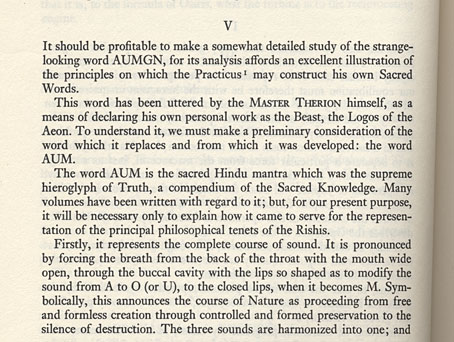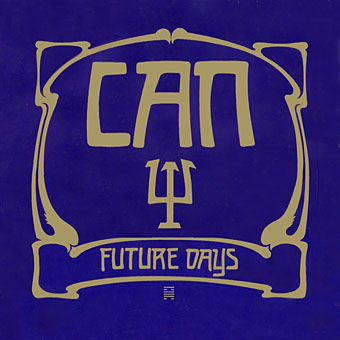
As usual, one thing leads to another. Most people who listen to Tago Mago (1971), the third album by Can, won’t be aware of the Aleister Crowley reference in the long improvisation that fills side three (track 5 on the CD). Aumgn was a spontaneous creation that includes one member of the band intoning an OM-like mantra while the other musicians clatter their way around the studio. The Crowley connection is in the unusual spelling of the title which is Crowley’s own amendment of the more familiar AUM. He explains the reasoning over several pages in Magick in Theory and Practice (1929), some of which involves the numerical values of the five letters. Not that this marks Can as Crowleyans but anyone unacquainted with Crowley’s augmented word would simply have used OM or AUM instead.
Update: I’ve been re-reading the book that came with the Can Box (1999), and came across this forgotten passage in Michael Karoli’s interview:
At the time I was very interested in magic spells, and Irmin knew of the spell “Aumgn” through me. But I had a completely different concept of what one could do with it, than to irreverently quote it in a piece of music. At the age of 21, I wouldn’t have dared to put this recklessly on an album. For me it was black magic. It was Aleister Crowley and all of that, and it gave me the creeps. I told Irmin to stop pronouncing magic spells in the room, but Irmin naturally overrode that with his arrogant grin.

Design by Ingo Trauer & Richard J. Rudow.
The fifth studio album, Future Days (1973) has another esoteric detail on the front and back of its elegant Art Nouveau sleeve: Hexagram 50 from the I Ching, translated in the Richard Wilhelm edition as Ting / The Cauldron. The same text has the judgement for Ting as “great good success”, and the album happens to be considered one of their best musically, although it was also the end of an era when vocalist Damo Suzuki left after its release. On a more mundane level, a cauldron is a container, as is a can.
There’s also the unexplained Greek letter in the centre of the sleeve: Psi is the 23rd letter of the Greek alphabet, and is commonly used as a symbol for psychology although it’s also used as a symbol in quantum mechanics. This last reference might be relevant given that the piece that ends their next album, Soon Over Babaluma (1974), is entitled Quantum Physics.

Design by Wagner Design Unit. Cover photos by Michael Karoli & Peter Hehner.
There are more I Ching hexagrams on the back of Flow Motion (1976), the group’s eighth album. Hexagram 29 is K’an / The Abysmal (Water) also known as “gorge” or “abyss”. Hexagram 59 is Huan / Dispersal (Dissolution). Taken together these could be interpreted as “flow motion” (and may well be the origin of the title—interviews with the group have seldom discussed these things) although they might also be seen as ominous signs for Can’s future. Flow Motion gave them a hit single in the UK (I Want More) but it’s also the last album that’s musically satisfying throughout. Can persevered for another two years (minus Holger Czukay) before disbanding in 1978. As to the esoterics, Rob Young is apparently writing a biography of the band so we may learn more about all of this when his book is published.
Previously on { feuilleton }
• Can soundtracks
• Can’s Lost Tapes
